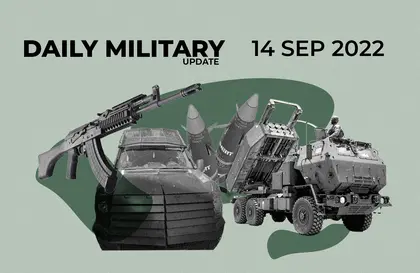The focus of fighting across the 2,000-kilometer front of Ukraine’s war with Russia shifted on Sep. 13, with combat activity flaring up in several locations in the Donbas and Kherson sectors.
There were relatively few reports of firing in the Kharkiv sector, the scene of a recent and highly successful Armed Forces of Ukraine (AFU) offensive.
JOIN US ON TELEGRAM
Follow our coverage of the war on the @Kyivpost_official.
According to Defense Ministry statements, the AFU conducted mopping up operations in dozens of villages across the Kharkiv sector, where advancing Ukrainian forces over the past week captured hundreds of abandoned pieces of Russian Federation (RF) military equipment and possibly dozens of prisoners.
Organized RF resistance in the Kharkiv sector is, at present, mostly negligible, the statement said.
Reports from the Defense Ministry and other official reports pointed out that the only properly organized RF defenses in Ukraine’s north-east are currently near towns to the north and south ends of the Oskil’ Reservoir in Kupyansk, and the same-named town of Oskil’.
RF units at both locations have effectively been surrounded and it is not clear how long they might hold out, an independent Ukrainian news report said.
Intense fighting around Lyman
Substantial back-and-forth ground fighting has been reported on the south flank of the AFU offensive in the Donetsk regional town of Lyman. According to information sources from both sides, a full-on infantry battle took place, with RF defenses stiffened by men from the BARS military police unit. The BARS officers sustained heavy AFU artillery fire but held out “bravely”, the pro-Russia Typychny Donetsk reported.

Ukraine War Causes Cocaine Traffic Surge in Russia, Russian Media Reports
AUF infantry broke into Lyman over the weekend. Strategically located on a road cutting through the forested Sviai Hory National Park, Lyman and its control was able to give Ukraine’s high command the option of pushing forces either north – to pursue RF forces fleeing west towards Kharkiv region – or south, to outflank and attack RF forces dug into strong defense lines in the Luhansk and Donetsk regions.
Serhiy Haidai, head of the Luhansk regional defense command, confirmed in a statement that neither side currently has full control of Lyman and that the town “is key for our region and we need to fight more here.”
He added that RF forces had abandoned the nearby towns Kreminna and Starobilsk and that AFU partisans had taken over that area. However, he did not provider evidence to support this claim.
Denis Pushilin, head of the unrecognized “Donetsk People’s Republic” (“DPR”) in a RuTube statement said that RF forces were standing firm at all positions, including Lyman. He added that in the town of Sviatohirsk, site of a 15th century monastery and a key crossing of the Siviersky Donetsk River, “DPR” forces had repelled UAF attacks with losses.
AFU-associated social media and official statements contradicted Pushilin’s claim regarding Sviatohirsk, with images of Ukrainian soldiers, police and civilians standing in front of church and civil administration buildings.
Some pro-RF sources claimed the AFU was putting the brakes on operations in the north to prepare for a new counter-offensive operation in the central Donbas, targeting the towns Severodonetsk, Marynka, Lysychansk and Pisky. The last successful RF offensive, ending in early June, captured those towns at heavy cost to military personnel.
Capacity of Russian forces
International military analysts, and more recently political talk shows on Russian state-controlled television, have linked the dramatic success of Ukraine’s Kharkiv offensive – recovering more than 5,000 square kilometers of territory in a little more than a week – to deep shortages of trained infantrymen and small unit commanders in frontline RF formations.
The Washington-based Institute for the Study of War (ISW) in a Sep. 13 situation report questioned whether the Kremlin could, at present, field sufficient ground forces to halt a major AFU offensive in Donbas.
Ukraine’s Army General Staff (AGS) in a Sep. 13 statement said offensive operations would go forward in all sectors but did not give details. RF units, the AGS statement said, were continuing systematic bombardment of Ukrainian homes and businesses across the Donbas front, hitting more than a dozen villages on Monday alone.
Meanwhile, RF sources accused the AFU of bombarding civilian infrastructure across the Donbas front, particularly in and around the city of Donetsk.
Activity in the southern sector
The southern sector, running from the Zaporizhzhia region to the Kherson region, as elsewhere, has recently seen mostly artillery exchanges and relatively few ground battles.
Ground fighting appeared to be taking place at crossing sites on the Inhulets River, particularly at the riverside town Davydiv Brid. Video and an eyewitness account to Kyiv Post said that UAF units were using military bridging to cross the river but that RF defenses further south were still organized and holding their positions.
On Sep. 12, a spokeswoman for Ukraine’s Joint Forces Command South claimed talks were in progress for a mass surrender of RF troops across the southern sector. On Sep. 14, RF units appeared still to be in their positions, and there were no reports of large numbers of RF Prisoners of War (POWs) reaching UAF lines.
You can also highlight the text and press Ctrl + Enter










